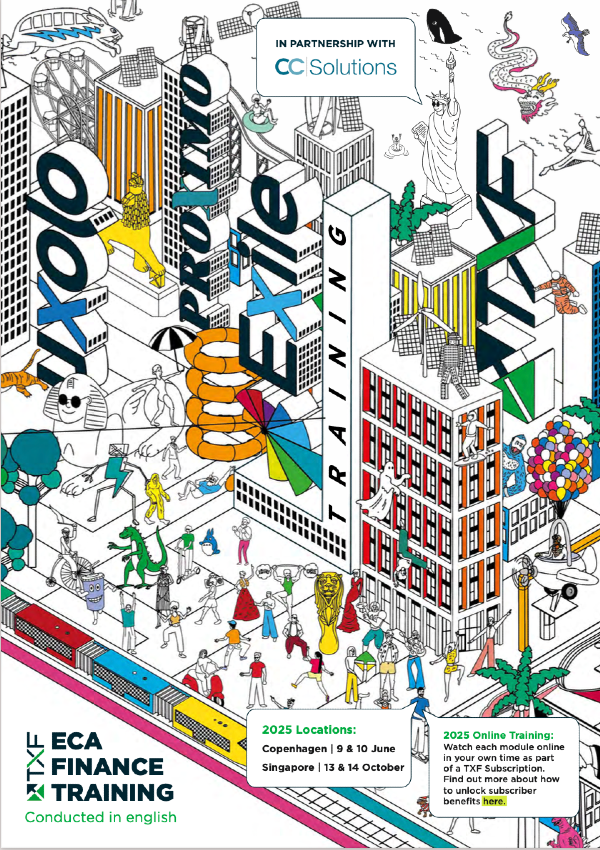Giddiness and stoicism on world trade and ESG at ITFA
The masks came off as building resilience in world trade and ESG ran in tandem at ITFA’s in person annual event in Bristol.

World trade is finding the balance between giddiness and stoicism [which is another take on the word resilience] a hard one to pull off. Giddiness was in evidence at International Trade and Forfaiting Association’s (ITFA’s) 47th annual conference, at what was the first physical event many of us had been at for a while. Nonetheless, stoicism ruled in the themes of building resilience and embedding ESG in financing international trade.
“We have all come back from fighting a war with an unknown enemy.” Sean Edwards, ITFA’s chair, started the Bristol conference quoting William Connor – who famously began his first post-war Cassandra column in the Daily Mirror in 1945 with, “As I was saying, before I was so rudely interrupted.” Edwards referred to the irony of the 2019 iteration of ITFA in Budapest which had a masked theme. This event was, for the most part, masks off as ITFA played host to many of its 250-plus member organisations (including a growing Fintech Committee and TFD Initiative on trade finance distribution).
Sugar rushes, resilience and the rebound – trade leads
Giddiness, or in the words of Sanjay Raja, UK Economist at Deutsche Bank, the current growth path can be identified as “the post sugar-rush recovery,” subsequent to the growth euphoria earlier this year (particularly in the UK). That means slower labour markets (including stagnant non-farm payrolls), inflation, and potential stagflation. Raja argues that the growth path is not a demand problem, rather a supply constraint challenge, particularly with so many workers having left the labour markets in developed economies.
There had been some giddiness in trade as the world stumbles out of the pandemic into the recovery. Global heads of trade finance joined me on stage to discuss their perspectives on the intersection between physical trade, economic growth with ESG embedded in it, and dislocations in trade.
“Interestingly, this is a very trade-led recovery. It's not capex led – it’s still wait and watch on the capex side,” says Surath Sengupta, managing director, global trade and receivables finance at HSBC. The biggest shift is that customers are looking at supply chains and at how to reorient them. Prior to the pandemic, supply chains had been driving down costs “to the last penny” and enhancing efficiencies. Those supply chains were found wanting in terms of resilience during the shock. Sengupta quoted an HSBC survey in which 93% of businesses responding said they were really concerned about resilience in their supply chains. “There is a huge shift to make supply chains more resilient, either by diversification or near-shoring, etc.”
Asia, particularly China, may have led the trade rebound but it by no means uniform – either by country or sector. Tech and e-enabled sectors are booming, which is creating trade finance opportunities, but there remain ‘stranded’ sectors such as hotels and airlines. Alberto Amo, global head private debt mobilisation at Santander, also sees a two-speed recovery with countries that have been able to support certain sectors during the pandemic gaining further advantage.
Supply constraints persist
Continued disruption of physical supply chains globally cannot be ignored. James Binns, managing director – trade and working capital at Barclays, notes that Drewry World Container Index, showed the spot price of a 40 foot container from Shanghai to Rotterdam on 30 September was more than five times higher than a year ago, with the composite index for containers more than doubling in the same period. And one of the surprises emerging from the pandemic has been the particular/unusual areas where fragility in supply chains exist (for instance, carbon dioxide supplies).
Helping build resilience for corporates facing such bubbles and dislocations remains a major driver for banks. Those supply shocks mean that while there are still high levels of liquidity in many companies which will remain conservative about how they spend their money. Even during the pandemic when export and import activity was slowing and commodity prices rising, supply chain finance and working capital demand have been robust, as has demand for trade finance products, as Kazuo Yoshimura, MD and general manager global trade finance at SMBC, says, noting that commodity clients used trade finance to boost cash and liquidity reserves during the pandemic.
Fixing the basics – giddiness and stoicism on trade digitisation
Binns argues that “resilience is the top of the pile” in terms of trends in any trade-led recovery. “And I put underneath that a number of key things: fixing the basics and digitisation is going to make us more resilient in the future. But we have to become more efficient and cost effective in the way we deal with things to make ourselves more resilient again. Digitisation is going to help us drive that. Also the ESG agenda is all about resilience from a global and humanity perspective.”
Indeed before pursing the more technologically ‘shiny’ solutions in digitisation (including AI and blockchain, banks and corporates still need to get some of the basic steps done to make themselves more connectible. Some banks have made strides in working on their own core infrastructure.
Digitisation of trade was a persistent theme – generating both giddiness and stoicism. While digitisation has been accelerated in part as a result of the pandemic, a lot of trade digitisation has centred on digital signatures rather than full process. As Daniel Cotti, managing director centre of excellence, banking and trade at Marco Polo, says, most of the processes are captured in PDF not data and PDFs are not electronic records. “Our experience is that the pandemic has made people even more conservative and while everyone sees the need for digitisation in trade few are doing it.” He hopes the adoption of Uniform Rules for Digital Trade Transactions (URDTT) will help contribute to corporates pushing for buyers and sellers to embrace digitisation with confidence.
Certainly, regulation of digitisation is making progress – as the event heard from UK Law Commissioner, Professor Sarah Green. The consultative body has responded to UK government requests to make recommendations to remove the legal block on digitisation of trade – particularly surrounding the possibility of ‘possessing’ e documents. There can only be one original – and that’s been a challenge for the English legal system. Green raised the interesting analogy for e trade documents of one person at a time being able to drive a car, but multiple keyholders being in existence.
International developments such as MLTER (model law on electronic transferable records) have been a helpful umbrella for trade digitisation, and no country is working in a vacuum. On 22 October, a communique by G7 heads of trade outlined further encouragement for trade digitisation. "To cut red tape and enable more businesses to trade, governments and industry should drive forward the digitisation of trade-related documents. This includes through means of addressing legal, technical, and commercial barriers to the digitisation of paper processes," the communique says.
Sustainability and resilience
ITFA’s ESG coverage in Bristol began with a discussion by a philosopher (Dr Joanna Burch Brown) asking all in the room to embrace collective action. For corporates, it’s no longer just about shareholder returns and profitability, it’s total societal returns, underlines HSBC’s Sengupta. “Shareholders and customers are demanding it of corporates, sustainability is a big theme that is all pervasive, and it's a huge opportunity for trade, finance and trade finance bankers because up to 80% of a company's carbon footprint is in the supply chain.”
There was a degree of stoicism on ESG at the event. Progress on sustainability is patchy, and not always meaningful, as Annabel Ross at Cambridge Institute says. While data is improving, there is very little intelligence, as Rebecca Harding at Coriolis Technologies says. Ian Sayers at International Trade Centre (ITC) notes more than 280 individual ESG standards can make the load on SMEs, in particular “almost unbearable”. He points to the example of shoe manufacturers in Pakistan burdened with “staggering” compliance costs. Keep it simple, and keep compliance costs low were Sayers’ requests.
Nonetheless, initiatives by DFIs such as ADB and Afreximbank are a positive addition to help SMEs access short term funds to grow sustainable trade and mitigate trade risk. Anything that can help the yawning $1.7 trillion trade gap is a bonus.
“Starting points” on Basel-compliant trade distribution
ITFA’s lobbying and advocacy drives have borne fruit over the past year. The insurance committee has helped with lobbying on wording to be used in association with CRD6, for instance. Trade distribution capacity will be impacted by the exit of several players from the trade credit market in the US (in particular QBR and Zurich) and UK. That makes the ITFA-supported suggestions to harmonising wording on Basel-compliant trade distribution documentation all the more welcome. The initiative, spearheaded by Scott Ettien, global head of trade credit at Willis Towers Watson, was spotlighted at the event. ITFA’s ESG and Trade Finance Committee, meanwhile (under the aegis of Credit Suisse’s Johanna Wissing) will no doubt be a force in the future.
Dance yourself dizzy
Giddiness in the form of dancing prevailed at ITFA’s Gala Dinner in Bristol, with a Hollywood theme and the excellent Ipop Showband. The steps for the dance of trade finance are certainly deeply embedded, even if we sometimes feel we may have forgotten them. Here is to more giddiness, and resilience.
Become a TXF subscriber for unrestricted access to TXFnews.com 365 days a year
Contact us for individual and team rates by emailingsubscriptions@txfmedia.com
Take a look below at some of the exclusive subscriber articles published last week
The trade credit village just got smaller. Does the Zurich exit matter?
Departures from parts of the trade credit and CPRI market – in particular by Zurich and QBE – have raised eyebrows as reduced capacity could make it harder for banks to secure a programme with a single insurer. What will be the impact, and can improved harmonisation of Basel-compliant documentation help bolster capacity?....Read on here
Stages for Change: ‘If you want to be part of the solution, then export finance is the industry for you’
In this fortnight’s Stages for Change interview, TXF’s Eavie Burnett speaks with Nedbank’s Mbali Kubheka on her growing career in export finance and the capacity it gives her to make real change....Read on here
Lowering the toll: The next step in the digital trade evolution
Why are there still so few bridges between digital islands? And no ‘cars’ on the bridges that have been built? Michael Vrontamitis, advisor at Kountable and Subra Shankar, founder and principal at TOTTA look at why digital islands persist, and how they can be bridged. Do not ignore smaller businesses....Read on here
Narrowing the gap with Trade-Finance-as-a-Service
While trade finance has an essential role to play in supporting the global economy through the post-COVID recovery, many firms are still unable to access the finance they need. Fortunately, technology can help banks meet their customers’ trade finance needs – and with cloud-based solutions, the cost of a specialist system is no longer prohibitive for small and mid-sized banks, as Surecomp’s Enno-Burghard Weitzel and Andrew Coles explain.....Read on here
Ninh Thuan wind refi out to lenders
AC Energy and BIM Group – sponsors of the $155 million 88MW Ninh Thuan wind project in Vietnam, which started operations earlier this month – are out to banks for....Read on here
Rockville Capital raises $100m financing for Chilean solar portfolio
Rockville Capital has reached financial close on a $100 million project financing for a portfolio of....Read on here
Midland Cogen refinancing closed
OMERS has closed on a refinancing for its....Read on here
LC extension for ConEd's California solar portfolio
Consolidated Edison Development has closed on an extension of a letter of credit for its...Read on here
Tanajib cogen reaches financial close
Marubeni and Taqa have reached financial close and signed the project agreements for.....Read on here
Myrtle solar-plus-BESS construction facility signed
TotalEnergies M Solar has raised construction financing for its Myrtle project – a 340MWac solar VV plus 225 MWh battery energy storage system (BESS) project in Brazoria County, Texas....Read on here
Matrix closes on Los Llanos PV post-construction financing
TGP-backed renewable energy platform Matrix Renewables has signed a COP114 billion ($30 million) long-term post-construction financing with the....Read on here
Hubert joins SWIFT trade strategy team
Terry Hubert has joined SWIFT in its trade strategy team. Hubert, whose most recent....Read on here
Chin starts at BMO
Timothy Chin has taken up his new role at BMO Capital Markets as head of Energy Transition within its Global Project and Structured Finance team....Read on here





